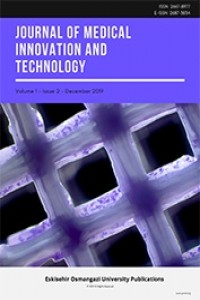Öz
Three dimensional (3D) printed models specific to the patients, decrease peroperative complications by providing preoperative surgical planning and application opportunities to the surgeon. The aim of this study is to determine the clinical results of preoperative surgical planning and application on 3D printed models, in patients with upper thoracic vertebral fracture treated via pedicle screw and posterior spinal fusion. 6 patients in total with upper thoracal fracture from our clinics were included to this study. 3D printer with custom design printing capability and lamellar printing technology was used for the production of 3D models. Preoperative surgical planning and application were perfomed on the models. The mean age of the patients was 47.16±13.40 (25-64). 4 (66.7%) of 6 patients were males and 2 (33.3%) were females. All presented after a history of trauma. The mean operation duration was 253.33±74.47 minutes (170-360). The mean duration of hospitalization was 13.83±9.06 days. Spinal instrumentation with the assistance from preoperative 3D models is an effecitve and reliable treatment for upper thoracic vertebral fractures. Use of the 3D models increases the ability of preoperative simulation in favor of the surgeon. This technique decreases the risk of screw malposition and shortens the operative duration thus enhances intraoperative reliability.
Anahtar Kelimeler
Kaynakça
- 1. Quinlan JF, Harty JA, O'Byrne JM.The need for multidisciplinary management of patients with upper thoracic spine fractures caused by high-velocity impact: a review of 32 surgically stabilised cases. J Orthop Surg (Hong Kong). 2005;13(1):34-9.
- 2. Anthes TB, Muangman N, Bulger E, Stern EJ. Upper thoracic spine fracture dislocation in a motorcyclist.Curr Probl Diagn Radiol. 2012;41(4):128-9.
- 3. Payer M. Unstable upper and middle thoracic fractures. Preliminary experience with a posterior transpedicular correction-fixation technique. J Clin Neurosci. 2005;12(5):529-33.
- 4. Vakharia VN, Vakharia NN, Hill CS. Review of 3-Dimensional Printing on Cranial Neurosurgery Simulation Training. World Neurosurg. 2016;88:188-98.
- 5. Ploch CC, Mansi C, Jayamohan J, Kuhl E. Using 3D Printing to Create Personalized Brain Models for Neurosurgical Training and Preoperative Planning. World Neurosurg. 2016;90:668-74.
- 6. Xu W, Zhang X, Ke T, Cai H, Gao X. 3D printing-assisted preoperative plan of pedicle screw placement for middle-upper thoracic trauma: a cohort study. BMC Musculoskelet Disord. 2017;18(1):348.
- 7. Lador R, Regev G, Salame K, Khashan M, Lidar Z. Use of 3-Dimensional Printing Technology in Complex Spine Surgeries. World Neurosurg. 2019 Sep 11. pii: S1878-8750(19)32431-3. doi: 10.1016/j.wneu.2019.09.002. [Epub ahead of print]
- 8. Chen D, Chen CH, Tang L, Wang K, Li YZ, Phan K, Wu AM. Three-dimensional reconstructions in spine and screw trajectory simulation on 3D digital images: a step by step approach by using Mimics software. J Spine Surg. 2017;3(4):650-656.
- 9. Payer M. Unstable upper and middle thoracic fractures. Preliminary experience with a posterior transpedicular correction-fixation technique. Clin Neurosci. 2005;12:5529–33.
- 10. Vaccaro AR, Rizzolo SJ, Allardyce TJ, Ramsey M, Salvo J, Balderston RA. Placement of pediclescrews in the thoracic spine. Part I: Morphometric analysis of the thoracic vertebrae. J Bone JointSurg Am. 1995;77(8):1193–9.
- 11. Yu CC, Bajwa NS, Toy JO, Ahn UM, Ahn NU. Pedicle morphometry of upper thoracic vertebrae: an anatomic study of 503 cadaveric specimens. Spine. 2005;39(20):1201–9.
- 12. Vaccaro A, Rizzolo SJ, Balderston RA, Allardyce TJ, Garfin SR, Dolinskas C, An HS. Placement of pedicle screws in the thoracic spine. Part II: an anatomical andradiographic assessment. J Bone Joint Surg Am. 1995;77(8):1200–6.
Öz
Anahtar Kelimeler
Kaynakça
- 1. Quinlan JF, Harty JA, O'Byrne JM.The need for multidisciplinary management of patients with upper thoracic spine fractures caused by high-velocity impact: a review of 32 surgically stabilised cases. J Orthop Surg (Hong Kong). 2005;13(1):34-9.
- 2. Anthes TB, Muangman N, Bulger E, Stern EJ. Upper thoracic spine fracture dislocation in a motorcyclist.Curr Probl Diagn Radiol. 2012;41(4):128-9.
- 3. Payer M. Unstable upper and middle thoracic fractures. Preliminary experience with a posterior transpedicular correction-fixation technique. J Clin Neurosci. 2005;12(5):529-33.
- 4. Vakharia VN, Vakharia NN, Hill CS. Review of 3-Dimensional Printing on Cranial Neurosurgery Simulation Training. World Neurosurg. 2016;88:188-98.
- 5. Ploch CC, Mansi C, Jayamohan J, Kuhl E. Using 3D Printing to Create Personalized Brain Models for Neurosurgical Training and Preoperative Planning. World Neurosurg. 2016;90:668-74.
- 6. Xu W, Zhang X, Ke T, Cai H, Gao X. 3D printing-assisted preoperative plan of pedicle screw placement for middle-upper thoracic trauma: a cohort study. BMC Musculoskelet Disord. 2017;18(1):348.
- 7. Lador R, Regev G, Salame K, Khashan M, Lidar Z. Use of 3-Dimensional Printing Technology in Complex Spine Surgeries. World Neurosurg. 2019 Sep 11. pii: S1878-8750(19)32431-3. doi: 10.1016/j.wneu.2019.09.002. [Epub ahead of print]
- 8. Chen D, Chen CH, Tang L, Wang K, Li YZ, Phan K, Wu AM. Three-dimensional reconstructions in spine and screw trajectory simulation on 3D digital images: a step by step approach by using Mimics software. J Spine Surg. 2017;3(4):650-656.
- 9. Payer M. Unstable upper and middle thoracic fractures. Preliminary experience with a posterior transpedicular correction-fixation technique. Clin Neurosci. 2005;12:5529–33.
- 10. Vaccaro AR, Rizzolo SJ, Allardyce TJ, Ramsey M, Salvo J, Balderston RA. Placement of pediclescrews in the thoracic spine. Part I: Morphometric analysis of the thoracic vertebrae. J Bone JointSurg Am. 1995;77(8):1193–9.
- 11. Yu CC, Bajwa NS, Toy JO, Ahn UM, Ahn NU. Pedicle morphometry of upper thoracic vertebrae: an anatomic study of 503 cadaveric specimens. Spine. 2005;39(20):1201–9.
- 12. Vaccaro A, Rizzolo SJ, Balderston RA, Allardyce TJ, Garfin SR, Dolinskas C, An HS. Placement of pedicle screws in the thoracic spine. Part II: an anatomical andradiographic assessment. J Bone Joint Surg Am. 1995;77(8):1200–6.
Ayrıntılar
| Birincil Dil | İngilizce |
|---|---|
| Konular | Cerrahi |
| Bölüm | Araştırma Makaleleri |
| Yazarlar | |
| Yayımlanma Tarihi | 16 Aralık 2019 |
| Yayımlandığı Sayı | Yıl 2019 Cilt: 1 Sayı: 2 |


